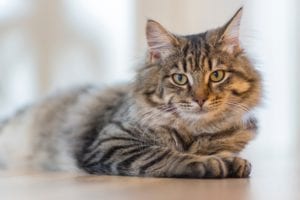Cats, Food and History:
For thousands of years, cats roamed the ancient world adopting habitats in every type of terrain and climate including the Savannahs of Africa, the plains of India and the forests of Eurasia and the Americas.
Being true carnivores they survived mainly on fresh small herbivores; rodents, birds and reptiles plus insects, and in the case of large cats, ruminants such as buffalo and deer.
A cat will eat the whole of its prey fresh, including entire rabbits (gut contents, offal and nervous tissue included). Unlike dogs, they do not scavenge and are obligate carnivores (they cannot be vegetarian).
By ingesting the entire animal they gain complete nutrition; the prey contains all the protein building blocks and fatty acids that they need as long as they are offered a variety (they have no requirement for grains, fruits or vegetables). They have an inherent need for significant protein levels in their diets, so a high protein diet is a normal diet for a cat (they are unable to synthesize essential amino acids such as taurine during times of protein restriction – this is in contrast to omnivores such as humans and dogs).
Commercial Diets:
Today we find ourselves faced with a huge choice of processed diets, both tinned and dry. With such a large choice we sometimes don’t know where to turn. There has been a big drive by manufacturers to create the perfect convenient diet, however, whole food protein sources are not cheap so many cat foods are manufactured using poor quality rendered proteins, some from non-meat sources. This affects the digestibility of the diet (how much goodness the cat can extract from the diet).
The protein levels in most cat foods are still not high enough especially as cats age – this often leads to loss of muscle mass especially as in our senior cats as their need for good quality protein increases as they age.
Carbohydrate levels in commercial diets are often much too high. Cats have not evolved to digest high amounts of starches, only obtaining a small amount of partially digested matter from the stomach contents of their prey. They have insufficient enzymes in their saliva and pancreas glands to process these complex sugars, and will often overeat leading to a multitude of problems.
In the case of kibble diets, the overall moisture level of the diet is also much reduced. Cats have evolved to obtain most of their water from the fresh prey they consume and often do not drink a large amount of water. The lowered water content of the diet can put stress on their digestive systems, liver and especially kidneys.
Raw Food:
It is possible to mimic a wild-type diet for cats within the home, but care needs to be taken to ensure the diet is balanced and suited to the individual. Many people mistake raw pet meats and minces available from their supermarket or pet shop as being a complete food. This is often not the case, with many just being minced muscle meat only, severely lacking in the important minerals and vitamins required to keep a cat healthy. This puts your cat at risk of developing nutritional diseases. Some pet minces also contain sulphur-based preservatives which not only have been linked to asthma in cats but also inactivate some important B vitamins. Fish also contains some enzymes which can reduce the availability of essential thiamine in the diet.
With knowledge and help from a veterinarian familiar with raw feeding, cats can eat a raw diet which is balanced and healthy, and with practice it does not need to be complicated. Also by offering a diet that cats were designed to eat we engage all their chewing anatomy encouraging good dental, digestive and mental health.
Here’s how it works:
The Basic Rules: Please note that the information below is no substitute for a discussion with a veterinarian familiar with raw feeding, who can individualize the diet for each patient based on their life stage and health issues.
Cats should be fed on a variety of raw meat:
- Sticking to one meat source is no good – each meat type has its own unique amino acid profile, so by offering variety you increase the nutrient range you cat ingests. Try to aim for three different types of meats during the week.
- Some minces have been prepared using the whole frame of the animal which provides an invaluable source of calcium and fats from the marrow. These are great for cats new to raw feeding and who are not ready to start chewing whole meaty bones. Generally, during a transition onto a raw diet and minces form part of the first stage. Once they have been eating and digesting these well for 2-3 weeks, you can then start to offer some meaty bones.
- Avoid minces with preservatives – these can trigger allergic reactions.
- Try to use meat sources that you could reasonably expect a feral cat to hunt in the wild (chicken, rabbit, hare and possum rather than beef). Keep fish intake to a maximum of three times per week.
- Make sure that any frozen meat used is consumed within 6 months (vitamin content falls during prolonged freezing).
For every 90-95g of meat, you can feed 5-10g of pureed raw veg (1-2 teaspoons):
- Cats will usually avoid vegetables at all costs but by pureeing the food you can smear it on the raw meat or mix it through the mince which will usually be eaten with gusto. Many cats don’t mind the sweeter vegetables such as carrot and pumpkin but try to include a wide variety including leafy greens if possible.
- To create a puree: Take any vegetables, especially green leafy ones, fruit and salad items and place in the liquidizer or juicer. You can use just one or two ingredients at any one time, but make sure you have variety from week to week. Blend to a puree. Add some water to give a liquid texture, if necessary. For convenience a batch of pureed vegetables can be made and then frozen in ice cubes so that small portions can be defrosted daily.
- For cats prone to constipation pureed pumpkin squash can be useful.
- Some cats will also eat a small amount of green tripe as an alternative to pureed vegetables which is a rich source of vegetable matter, pre and probiotics, digestive enzymes and fatty acids.
- Do not feed onions or garlic which are toxic to cats.
Feed raw meaty bones (chicken wings and necks are the most popular, and rabbit for those who can get hold of it):
- Some people worry about feeding bones to their cats. There are two circumstances under which bone feeding is dangerous. If the bone is cooked (becoming splintery and hard) and if inappropriately sized bones are fed. Bones that are too small can be a choking hazard for pets new to raw feeding and bones too large can fracture teeth.
- Bones should be fed with plenty of meat on them and should be from a prey source which your pet could reasonably be expected to hunt if they were in the wild (chicken, rabbit, hare, possum). A meat only diet is highly imbalanced. Raw chicken wings and necks are most commonly used.
- Feed raw meaty bones every 2-3 days.
- For cats new to raw feeding start with uncooked minces made from chicken frames/ rabbit & hare frames and possum frames – once they are eating this well then start to introduce whole meaty bones.
Feed fresh tripe (kidney, heart, lung or liver) once a week or 1/6 of daily intake:
- Tripe is a necessary part of a balanced diet as it is very high in certain vitamins.
- Vary the organ meat weekly, but make sure heart is often on the menu. Cats cannot live without Taurine, found in high amounts in heart tissue.
- Some frozen pet minces already contain small amounts of heart, liver and kidney in their mix.
- Take care not to over feed liver (maximum once a week).
Quantities:
A general rule is to feed 2% of the body weight (5kg cat will need approximately 100gm food per day). Adjust the amounts depending on the cat’s activity levels, metabolism and age. If you are unsure if your cat is the correct weight please make an appointment with the veterinarian to have this assessed.
Do not feed cereals and do not mix raw feeding with processed commercial cat food as the stomach will never adapt to digest the raw diet fully.
Homemade vitamin and mineral supplement:
A well balanced raw diet should not require the addition of vitamins or minerals, and there is a risk that by doing so you create an imbalanced diet. There may be some situations where a supplement may be recommended but this needs to be under the supervision of the veterinarian.
Troubleshooting:
- Cats not used to raw feeding may take some time to get used to the new food. Starting with chunks of poached meat can sometimes encourage them to try something new as this will enhance the meats flavor and smell, a big factor affecting palatability in cats. Initially, this will not be a balanced diet but for a short period of 4-6 weeks during a transition to raw this is okay.
- Older cats may also sometimes require light cooking of the food to aid digestion and palatability. Also, older cats will benefit from the more easily digestible white meats.
- Ideally, feed once per day. In the wild cats would not always be successful in hunting and short periods of fasting would be normal. In warmer weather is it best to feed once per day in the evening when it is cooler so the meat does not spoil or attract flies.
- Young kittens can be weaned directly onto raw feeding offering 4 small meals per day of a minced mix from 3-4 weeks till 8 weeks. After 8 weeks reduce minces to 2/3 diet with 1/3 fillets and organ needs plus start daily meaty bones. Amounts are increased to 6-10% of their body weight (60-100gm per kilo).
- For cats suffering from chronic vomiting or diarrhea it is best to work with the veterinarian and start with bone broths in order to heal the gut. Over time they are gradually transitioned onto raw feeding introducing poached meats first.
- Cats with no or few teeth will need minced frames instead of meaty bones.

Cats fed a balanced raw diet have more acidic stomach acid then those fed on biscuits. This combined with the presence of anti-bacterial salivary enzymes and a short gut means they are less likely to develop illness from exposure to pathogens.
Sourcing high quality food from the human food-chain and ensuring that it has been adequately frozen + feeding in a sensible manner will reduce the risks.
In terms of human health, pet owners should apply the same hygiene standards that they employ when dealing with food intended for their own consumption.
Further information:
This advice sheet has been made with the help of information from Lyn Thompson at www.rawessentials.co.nz. More information about raw feeding and holistic health matters can also be found by speaking to Wendy Dixon at New Plymouth Vet Group (06 7584006) or St Aubyn Veterinary clinic (06 7513000).
Useful books to read:
The Barf Diet: For Cats and Dogs by Ian Billinghurst
The bible for all those interested in feeding raw food to cats and dogs for both beginners and the experienced.
Raw Meaty Bones: Promote Health by Tom Lonsdale
A peer reviewed and fully referenced book of information on raw feeding for pet owners and veterinarians. Tom Lonsdale a veterinary expert on species appropriate nutrition.
Tom Lonsdale a veterinary expert on species appropriate nutrition gives some hints on how to start your car on raw feeding here; http://www.rawmeatybones.com/petowners/switchingcats.php
Content updated 26.02.19

